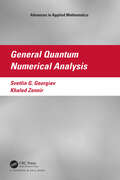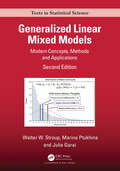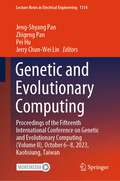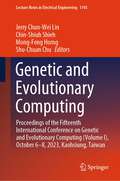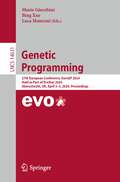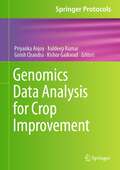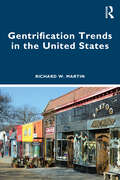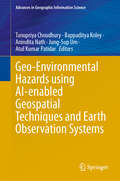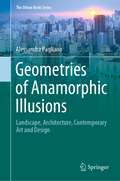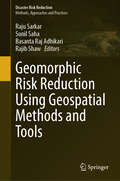- Table View
- List View
Game Theory with Applications in Operations Management (Springer Texts in Business and Economics)
by R. K. AmitThis book provides a broad picture of solution concepts that are highly applicable to operations and supply chain settings and to explicate these concepts with some of the relevant problems in operations management in multi-agent settings. It discusses different strategic situations like games in normal form, games in extensive form, games of incomplete information, mechanism design, and cooperative games, to solve operations problems of supply chain coordination, capacity planning, revenue and pricing management, and other complex problems of matching supply with demand. The recognition and adoption of game-theoretic modeling for operations and supply chain management problems in multi-agent settings have been a hallmark of operations and supply chain literature research during the last few years. Despite research in operations and supply chain management having embraced both non-cooperative and cooperative game-theoretic solution concepts, there is still an abundance of underutilized concepts and tools in game theory that could strongly influence operations management problems. Additionally, with the increasing digitization of operations and supply chain management, the narrative of problems in these areas focuses on blockchain and smart contracts, platforms, and shared economy. The book profits from these new issues being predominantly multi-agent settings and lending themselves to game-theoretical solution concepts. The book's intended audience is the advanced undergraduate and graduate student community of operations and supply chain management, economics, mathematics, computer science, and industrial engineering. It is also relevant for the research community and industry practitioners who use multi-agent architecture in business problems.
Games, Decisions, and Markets (New Frontiers in Regional Science: Asian Perspectives #74)
by Yasuhiro SakaiThis book critically discusses the historical backgrounds and new developments of the theories of games, decisions, and markets, with many possible applications to social and economic problems. Consisting of three connected parts, the book sheds new light on the role of merchants in the market economy under conditions of risk and uncertainty. Part I begins with the question of why and how John von Neumann and Oskar Morgenstern did joint work in game theory, namely, the theoretical study of strategic interactions among several decision makers. The duel between Sherlock Holmes and Professor Moriarty in Conan Doyle's famous detective story is recalled as a great inducement to Neumann and Morgenstern to invent zero-sum, two-person games. More general non-zero-sum games and associated Nash solutions are then discussed in relation to the generation-gap problem between a young couple and an elderly couple. Part II explores a set of very fundamental problems of individual decision making. Thetwo famous axioms of revealed preference ― Samuelson's weak axiom and Houthakker's axiom ― are skillfully connected and empirically reevaluated by the introduction of certain regularity conditions. The revealed preference approach is then extended from the original commodity space to the dual price space. Such dual treatment in microeconomics is further applied to the theory of cost and production, with the decomposition of the total factor price effect into the substitution and scale effects. Part III turns the reader’s attention to the interdependence of several markets. The almost forgotten Hicks–Morishima approach is newly revived with graphical illustrations of traded goods. The well-known Jones–Kemp approach to international trade is boldly expanded into the world of risk and uncertainty. Some striking results in comparative static analysis are derived, with favorable implications for the real world.
Gender & Diversity Studies in MINT meets Naturwissenschaftsdidaktik: Synergien und Impulse für eine gender- & diversitätssensible Forschung und Lehre der Naturwissenschaften (Edition Fachdidaktiken)
by Martina Erlemann Sarah HuchGender und dessen Zusammenwirken mit weiteren Diversity-Dimensionen wie etwa soziale Herkunft, ein (zugeschriebener) Migrationshintergrund oder sexuelle Orientierung stehen an Hochschulen verstärkt im Fokus. Gefordert sind dabei auch gender- und diversitysensible Ausrichtungen der Forschung und Lehre der MINT-Fächer sowie der hochschulischen Lehramtsausbildung für MINT. Welche inhaltliche Relevanz haben Gender- und Diversity-Aspekte in Fachkultur, Forschungsinhalten sowie im Wissenschaftsverständnis der Naturwissenschaften? Wie strukturieren Geschlecht und andere soziale Differenzkategorien die Forschung? Wie kann eine Gender- und Diversity-Kompetenzen vermittelnde Lehrer*innenbildung aussehen?Auf diese Fragen geben die interdisziplinären Beiträge der Wissenschaftler*innen, etwa aus Physik, Biologie, Medizin, Feminist Science & Technology Studies sowie die naturwissenschaftlichen Fachdidaktiken Antworten. Ansätze sowie Wissensbestände der Gender & Diversity Studies in MINT werden mit den gender- und diversityausgerichteten Naturwissenschaftsdidaktiken zusammengeführt. Mit vielfältigen Anregungen ermutigen sie zu einer gender- und diversityorientierten Ausrichtung der (eigenen) Forschung und Lehre.
The General Kelvin-Helmholtz Stability Model: With Applications to Sand Wave and Water Wave Generation
by Hermann MoshagenThis book presents a generalized version of the classical Kelvin-Helmholtz instability, a useful tool which allows for new approaches when studying stability problems in fluid mechanics, as well as its important applications. It begins by providing an introduction to hydrodynamic stability and the Kelvin-Helmholtz (KH) instability. The author then develops the general KH stability model for a multi-layer flow system, which includes the conventional KH instability as a special case. This book also includes the detailed discussion of two important applications of this model: the generation of sand waves in alluvial channels and the generation of wind waves on water. Additionally, the effects of nonlinearities and the use of computational methods to study KH instability are included. This book serves as a concise and modern treatment of the KH stability model with specific attention paid to hydrodynamic stability analysis. It is ideal for graduate students interested in fluid dynamics as well as scientists and engineers in the fields of oceanography, geophysics, offshore engineering, and more.
General Quantum Numerical Analysis (ISSN)
by Svetlin G. Georgiev Khaled ZennirThis book is focused on the qualitative theory of general quantum calculus, the modern name for the investigation of calculus without limits. It centers on designing, analysing and applying computational techniques for general quantum differential equations. The quantum calculus or q-calculus began with F.H. Jackson in the early twentieth century, but this kind of calculus had already been worked out by Euler and Jacobi. Recently, it has aroused interest due to high demand of mathematics that models quantum computing and the connection between mathematics and physics.Quantum calculus has many applications in different mathematical areas such as number theory, combinatorics, orthogonal polynomials, basic hyper-geometric functions and other sciences such as quantum theory, mechanics and the theory of relativity.The authors summarize the most recent contributions in this area. General Quantum Numerical Analysis is intended for senior undergraduate students and beginning graduate students of engineering and science courses. The twelve chapters in this book are pedagogically organized, each concluding with a section of practical problems.
General Quantum Numerical Analysis (ISSN)
by Svetlin G. Georgiev Khaled ZennirThis book is focused on the qualitative theory of general quantum calculus, the modern name for the investigation of calculus without limits. It centers on designing, analysing and applying computational techniques for general quantum differential equations. The quantum calculus or q-calculus began with F.H. Jackson in the early twentieth century, but this kind of calculus had already been worked out by Euler and Jacobi. Recently, it has aroused interest due to high demand of mathematics that models quantum computing and the connection between mathematics and physics.Quantum calculus has many applications in different mathematical areas such as number theory, combinatorics, orthogonal polynomials, basic hyper-geometric functions and other sciences such as quantum theory, mechanics and the theory of relativity.The authors summarize the most recent contributions in this area. General Quantum Numerical Analysis is intended for senior undergraduate students and beginning graduate students of engineering and science courses. The twelve chapters in this book are pedagogically organized, each concluding with a section of practical problems.
General Theory of Leibniz Algebras (Synthesis Lectures on Mathematics & Statistics)
by Leonid Kurdachenko Oleksandr Pypka Igor SubbotinThis book discusses many interesting results have been obtained in Leibniz algebras over the past two decades. The authors not only summarize recent results and methods successfully used in Leibniz algebras, but also show new prospective horizons. Any mathematical theories have a number of natural problems that arise in the process of its development, and these problems quite often have analogues in other areas such as differential geometry, homological algebra, classical algebraic topology, noncommutative geometry, etc. With this in mind the authors describe the general structure of Leibniz algebras that have already been discovered. This approach allows readers to see which parts of the theory should be developed further and also shows the significant differences of Leibniz algebras from Lie algebras. Recent results that constitute the naturally evolving general theory of the subject are then explored.
Generalized Linear Mixed Models: Modern Concepts, Methods and Applications (Chapman & Hall/CRC Texts in Statistical Science)
by Walter W. Stroup Marina Ptukhina Julie GaraiGeneralized Linear Mixed Models: Modern Concepts, Methods, and Applications (2nd edition) presents an updated introduction to linear modeling using the generalized linear mixed model (GLMM) as the overarching conceptual framework. For students new to statistical modeling, this book helps them see the big picture – linear modeling as broadly understood and its intimate connection with statistical design and mathematical statistics. For readers experienced in statistical practice, but new to GLMMs, the book provides a comprehensive introduction to GLMM methodology and its underlying theory.Unlike textbooks that focus on classical linear models or generalized linear models or mixed models, this book covers all of the above as members of a unified GLMM family of linear models. In addition to essential theory and methodology, this book features a rich collection of examples using SAS® software to illustrate GLMM practice. This second edition is updated to reflect lessons learned and experience gained regarding best practices and modeling choices faced by GLMM practitioners. New to this edition are two chapters focusing on Bayesian methods for GLMMs.Key Features:• Most statistical modeling books cover classical linear models or advanced generalized and mixed models; this book covers all members of the GLMM family – classical and advanced models.• Incorporates lessons learned from experience and on-going research to provide up-to-date examples of best practices.• Illustrates connections between statistical design and modeling: guidelines for translating study design into appropriate model and in-depth illustrations of how to implement these guidelines; use of GLMM methods to improve planning and design.• Discusses the difference between marginal and conditional models, differences in the inference space they are intended to address and when each type of model is appropriate.• In addition to likelihood-based frequentist estimation and inference, provides a brief introduction to Bayesian methods for GLMMs.Walt Stroup is an Emeritus Professor of Statistics. He served on the University of Nebraska statistics faculty for over 40 years, specializing in statistical modeling and statistical design. He is a Fellow of the American Statistical Association, winner of the University of Nebraska Outstanding Teaching and Innovative Curriculum Award and author or co-author of three books on mixed models and their extensions.Marina Ptukhina (Pa-too-he-nuh), PhD, is an Associate Professor of Statistics at Whitman College. She is interested in statistical modeling, design and analysis of research studies and their applications. Her research includes applications of statistics to economics, biostatistics and statistical education. Ptukhina earned a PhD in Statistics from the University of Nebraska-Lincoln, a Master of Science degree in Mathematics from Texas Tech University and a Specialist degree in Management from The National Technical University "Kharkiv Polytechnic Institute."Julie Garai, PhD, is a Data Scientist at Loop. She earned her PhD in Statistics from the University of Nebraska-Lincoln and a bachelor’s degree in Mathematics and Spanish from Doane College. Dr Garai actively collaborates with statisticians, psychologists, ecologists, forest scientists, software engineers, and business leaders in academia and industry. In her spare time, she enjoys leisurely walks with her dogs, dance parties with her children, and playing the trombone.
Generalized Linear Mixed Models: Modern Concepts, Methods and Applications (Chapman & Hall/CRC Texts in Statistical Science)
by Walter W. Stroup Marina Ptukhina Julie GaraiGeneralized Linear Mixed Models: Modern Concepts, Methods, and Applications (2nd edition) presents an updated introduction to linear modeling using the generalized linear mixed model (GLMM) as the overarching conceptual framework. For students new to statistical modeling, this book helps them see the big picture – linear modeling as broadly understood and its intimate connection with statistical design and mathematical statistics. For readers experienced in statistical practice, but new to GLMMs, the book provides a comprehensive introduction to GLMM methodology and its underlying theory.Unlike textbooks that focus on classical linear models or generalized linear models or mixed models, this book covers all of the above as members of a unified GLMM family of linear models. In addition to essential theory and methodology, this book features a rich collection of examples using SAS® software to illustrate GLMM practice. This second edition is updated to reflect lessons learned and experience gained regarding best practices and modeling choices faced by GLMM practitioners. New to this edition are two chapters focusing on Bayesian methods for GLMMs.Key Features:• Most statistical modeling books cover classical linear models or advanced generalized and mixed models; this book covers all members of the GLMM family – classical and advanced models.• Incorporates lessons learned from experience and on-going research to provide up-to-date examples of best practices.• Illustrates connections between statistical design and modeling: guidelines for translating study design into appropriate model and in-depth illustrations of how to implement these guidelines; use of GLMM methods to improve planning and design.• Discusses the difference between marginal and conditional models, differences in the inference space they are intended to address and when each type of model is appropriate.• In addition to likelihood-based frequentist estimation and inference, provides a brief introduction to Bayesian methods for GLMMs.Walt Stroup is an Emeritus Professor of Statistics. He served on the University of Nebraska statistics faculty for over 40 years, specializing in statistical modeling and statistical design. He is a Fellow of the American Statistical Association, winner of the University of Nebraska Outstanding Teaching and Innovative Curriculum Award and author or co-author of three books on mixed models and their extensions.Marina Ptukhina (Pa-too-he-nuh), PhD, is an Associate Professor of Statistics at Whitman College. She is interested in statistical modeling, design and analysis of research studies and their applications. Her research includes applications of statistics to economics, biostatistics and statistical education. Ptukhina earned a PhD in Statistics from the University of Nebraska-Lincoln, a Master of Science degree in Mathematics from Texas Tech University and a Specialist degree in Management from The National Technical University "Kharkiv Polytechnic Institute."Julie Garai, PhD, is a Data Scientist at Loop. She earned her PhD in Statistics from the University of Nebraska-Lincoln and a bachelor’s degree in Mathematics and Spanish from Doane College. Dr Garai actively collaborates with statisticians, psychologists, ecologists, forest scientists, software engineers, and business leaders in academia and industry. In her spare time, she enjoys leisurely walks with her dogs, dance parties with her children, and playing the trombone.
Generative Artificial Intelligence: Exploring the Power and Potential of Generative AI
by Shivam R Solanki Drupad K KhublaniThis book explains the field of Generative Artificial Intelligence (AI), focusing on its potential and applications, and aims to provide you with an understanding of the underlying principles, techniques, and practical use cases of Generative AI models. The book begins with an introduction to the foundations of Generative AI, including an overview of the field, its evolution, and its significance in today’s AI landscape. It focuses on generative visual models, exploring the exciting field of transforming text into images and videos. A chapter covering text-to-video generation provides insights into synthesizing videos from textual descriptions, opening up new possibilities for creative content generation. A chapter covers generative audio models and prompt-to-audio synthesis using Text-to-Speech (TTS) techniques. Then the book switch gears to dive into generative text models, exploring the concepts of Large Language Models (LLMs), natural language generation (NLG), fine-tuning, prompt tuning, and reinforcement learning. The book explores techniques for fixing LLMs and making them grounded and indestructible, along with practical applications in enterprise-grade applications such as question answering, summarization, and knowledge-based generation. By the end of this book, you will understand Generative text, and audio and visual models, and have the knowledge and tools necessary to harness the creative and transformative capabilities of Generative AI. What You Will Learn What is Generative Artificial Intelligence? What are text-to-image synthesis techniques and conditional image generation? What is prompt-to-audio synthesis using Text-to-Speech (TTS) techniques? What are text-to-video models and how do you tune them? What are large language models, and how do you tune them? Who This Book Is For Those with intermediate to advanced technical knowledge in artificial intelligence and machine learning
Genetic and Evolutionary Computing: Proceedings of the Fifteenth International Conference on Genetic and Evolutionary Computing (Volume II), October 6-8, 2023, Kaohsiung, Taiwan (Lecture Notes in Electrical Engineering #1114)
by Jeng-Shyang Pan Zhigeng Pan Pei Hu Jerry Chun-Wei LinThis second volume of conference proceedings contains selected papers presented at ICGEC 2023, the 15th International Conference on Genetic and Evolutionary Computing, held on October 6-8, 2023 in Kaohsiung, Taiwan. The conference is intended as an international forum for the researchers and professionals in all areas of genetic and evolutionary computing. And the readers may know the up-to-date techniques of the mentioned topics, including technologies for next-generation network environments, recent progress in computational electromagnetic dynamics, future cyber security, privacy and forensics for advanced systems, data mining techniques and its applications, optimization models in deep learning and machine learning. It will help readers bring new ideas or apply the designed approaches from the collected papers to their professional jobs.
Genetic and Evolutionary Computing: Proceedings of the Fifteenth International Conference on Genetic and Evolutionary Computing (Volume I), October 6–8, 2023, Kaohsiung, Taiwan (Lecture Notes in Electrical Engineering #1145)
by Jerry Chun-Wei Lin Chin-Shiuh Shieh Mong-Fong Horng Shu-Chuan ChuThis first book of conference proceedings contains selected papers presented at ICGEC 2023, the 15th International Conference on Genetic and Evolutionary Computing, held on October 6–8, 2023, in Kaohsiung, Taiwan. The conference is intended as an international forum for the researchers and professionals in all areas of genetic and evolutionary computing. And the readers know the up-to-date techniques of the mentioned topics, including swarm intelligence and its applications, operational technologies and networked multimedia applications, wearable computing and intelligent data hiding, image processing and intelligent applications, and intelligent multimedia tools and applications. It helps readers bring new ideas or apply the designed approaches from the collected papers to their professional jobs.
Genetic Programming: 27th European Conference, EuroGP 2024, Held as Part of EvoStar 2024, Aberystwyth, UK, April 3–5, 2024, Proceedings (Lecture Notes in Computer Science #14631)
by Mario Giacobini Bing Xue Luca ManzoniThis book constitutes the refereed proceedings of the 27th European Conference on Genetic Programming, EuroGP 2024, held in Aberystwyth, UK, April 3–5, 2024 and co-located with the EvoStar events, EvoCOP, EvoMUSART, and EvoApplications.The 13 papers (9 selected for long presentation and 4 for short presentation) collected in this book were carefully reviewed and selected from 24 submissions. The wide range of topics in this volume reflects the current state of research in the field. The collection of papers cover topics including developing new variants of GP algorithms, as well as exploring GP applications to the optimization of machine learning methods and the evolution of control policies.
Genomics Data Analysis for Crop Improvement (Springer Protocols Handbooks)
by Priyanka Anjoy Kuldeep Kumar Girish Chandra Kishor GaikwadThis book addresses complex problems associated with crop improvement programs, using a wide range of programming solutions, for genomics data handling and sustainable agriculture. It describes important concepts in genomics data analysis and sequence-based mapping approaches along with references. The book contains 16 chapters on recent developments in several methods of genomic data analysis for crop improvements and sustainable agriculture, all authored by eminent researchers who are experts in their fields. These chapters focus on applications of a wide range of key bioinformatics topics, including assembly, annotation, and visualization of next-generation sequencing (NGS) data; expression profiles of coding and noncoding RNA; statistical and quantitative genetics; trait-based association analysis, quantitative trait loci (QTL) mapping, and artificial intelligence in genomic studies. Real examples and case studies in the book will come in handy when applying the techniques. The relative scarcity of reference materials covering bioinformatics applications as compared with the readily available books also enhances the utility of this book. The targeted readers of the book are scientists, researchers, and bioinformaticians from genomics and advanced breeding in different areas. The book will appeal to the applied researchers engaged in crop improvements and sustainable agriculture by using bioinformatics tools, students, research project leaders, and practitioners from the various marginal disciplines and interdisciplinary research.
Gentrification Trends in the United States
by Richard W. MartinGentrification Trends in the United States is the first book to quantify the changes that take place when a neighborhood’s income level, educational attainment, or occupational makeup outpace the city as a whole – the much-debated yet poorly understood phenomenon of gentrification. Applying a novel method to four decades of U.S. Census data, this resource for students and scholars provides a quantitative basis for the nuanced demographic trends uncovered through ethnography and other forms of qualitative research. This analysis of a rich data source characterized by a broad regional and chronological scope provides new insight into larger questions about the nature and prevalence of gentrification across the United States. Has gentrification become more common over time? Which cities have experienced the most gentrification? Is gentrification widespread, or does it tend to be concentrated in a small number of cities? Has the nature of gentrification changed over time? Ideal reading for courses in real estate, urban planning, urban economics, sociology, geography, econometrics, and GIS, this pathbreaking addition to the urban studies literature will enrich the perspective of any scholar of U.S. cities.
Gentrification Trends in the United States
by Richard W. MartinGentrification Trends in the United States is the first book to quantify the changes that take place when a neighborhood’s income level, educational attainment, or occupational makeup outpace the city as a whole – the much-debated yet poorly understood phenomenon of gentrification. Applying a novel method to four decades of U.S. Census data, this resource for students and scholars provides a quantitative basis for the nuanced demographic trends uncovered through ethnography and other forms of qualitative research. This analysis of a rich data source characterized by a broad regional and chronological scope provides new insight into larger questions about the nature and prevalence of gentrification across the United States. Has gentrification become more common over time? Which cities have experienced the most gentrification? Is gentrification widespread, or does it tend to be concentrated in a small number of cities? Has the nature of gentrification changed over time? Ideal reading for courses in real estate, urban planning, urban economics, sociology, geography, econometrics, and GIS, this pathbreaking addition to the urban studies literature will enrich the perspective of any scholar of U.S. cities.
Geo-Environmental Hazards using AI-enabled Geospatial Techniques and Earth Observation Systems (Advances in Geographic Information Science)
by Jung-Sup Um Tanupriya Choudhury Bappaditya Koley Anindita Nath Atul Kumar PatidarThis edited collection provides a comprehensive exploration of cutting-edge ideas, approaches, simulations, evaluations of risk, and systems that enhance the practicality of current geospatial technologies for reducing hazard risks. The various sections within this book delve into subjects such as the foundational principles of Earth Observation Systems (EOS) and geospatial methodologies. Additionally, the text serves as an advisory resource on the collaborative use of satellite-derived data and artificial intelligence to track and alleviate geo-environmental threats. The volume imparts extensive understanding regarding geo-environmental dangers and their analysis via EOS along with geospatial strategies. It encompasses key hazard-related themes including coastal degradation, predisposition to landslides, mapping vegetation coverages, tropical storm patterns, soil depletion due to erosion processes, vulnerability to rapid or extended flooding events, variations in oceansurface temperatures alongside chlorophyll-a levels; it also addresses assessments related to groundwater reserves and quality measures as well as sustainable management practices for watersheds that support community livelihoods—all through leveraging AI-integrated geospatial tools in conjunction with earth observation technologies. Furthermore, this work engages in discourse about systems designed for mitigating these ecological challenges sustainably. Scholars engaged in research activities; educational professionals; those involved in landscape design; engineers working at ground level; individuals responsible for policy-making—all who are concerned with geo-environmental hazards or associated domains—will find valuable insights within these pages.
Geographic Data Analysis Using R
by Xindong HeThis book is structured to encompass both the foundational and specialized aspects of quantitative analysis in geography. The basic content covers descriptive statistical analysis and correlation analysis of geographical data, while the professional content delves into more advanced topics like linear regression analysis, geographically weighted regression analysis, time series analysis, cluster analysis, principal component analysis, Markov chain analysis, and geographical network analysis. The methodologies span from widely utilized techniques to more recent developments, and the data primarily originates from reputable sources in China. The example code provided in the book can be executed using R packages available on the CRAN website.This book is an invaluable resource for undergraduate and graduate students, as well as researchers interested in learning and applying R for processing, visualizing, and analyzing geographic data. It serves as an introductory course in quantitative methods in geography for students in geography departments. Additionally, it is an ideal supplementary text for applied methods courses across various disciplines that involve geographic data, such as human and physical geography, geographic information science, ecology, public health, crime, and economics.
Geometric Methods in Physics XL: Workshop, Białowieża, Poland, 2023 (Trends in Mathematics)
by Piotr Kielanowski Daniel Beltita Alina Dobrogowska Tomasz GolińskiThis volume collects papers based on lectures given at the XL Workshop on Geometric Methods in Physics, held in Białowieża, Poland in July 2023. These chapters provide readers an overview of cutting-edge research in infinite-dimensional groups, integrable systems, quantum groups, Lie algebras and their generalizations and a wide variety of other areas. Specific topics include: Yang-Baxter equation The restricted Siegel disc and restricted Grassmannian Geometric and deformation quantization Degenerate integrability Lie algebroids and groupoids Skew braces Geometric Methods in Physics XL will be a valuable resource for mathematicians and physicists interested in recent developments at the intersection of these areas.
A Geometrical Approach to Physics
by David A. Burton Adam NobleThis book provides an accessible introduction to using the tools of differential geometry to tackle a wide range of topics in physics, with the concepts developed through numerous examples to help the reader become familiar with the techniques.Physical applications are used to develop the techniques and demonstrate their wide-ranging applicability. Formalism is introduced sparingly and step-by-step, where it is needed, and chapters contain exercises for readers to test their understanding. Worked solutions to the exercises are included.It is an ideal textbook for advanced undergraduate or postgraduate courses on mathematical methods for physicists, for students whose background is in physics rather than mathematics. It is assumed that the reader has no prior knowledge of mathematical methods beyond the content of a standard undergraduate physics degree.The purpose of the book is to act as a ‘gateway’ to more advanced books on the applications of differential geometry in physics. It will also help the reader to better appreciate modern physics research that makes use of differential geometry, and the common features that permeate the discipline as a whole.Key Features: Presents a light and accessible treatment. Can be used as a textbook for a short course on mathematical methods for physicists. Accessible to advanced undergraduates and postgraduates whose background is in physics, not mathematics. David A. Burton received his PhD from Lancaster University, UK, in 2000 and was appointed Lecturer in Physics there in 2005. He is currently Senior Lecturer in Physics at Lancaster. He began his research career in relativistic continuum mechanics and gravitational physics before turning to fluid-structure interactions (in particular, vortex-induced vibration) and, in later years, to relativistic laser-plasma interactions.Adam Noble received his PhD in 2006, also from Lancaster University, and has since held postdoctoral positions at Lancaster and the University of Strathclyde, Scotland, where he is currently a Research Fellow. His interests lie at the interface of physics with geometry, in particular electrodynamics of intense fields, plasma physics and particle physics.The authors maintain a long-standing collaboration and, over the years, have worked on a number of topics connecting electromagnetics, gravitation and plasma physics, including gravitational Sagnac interferometry, relativistic wave-breaking in plasmas, radiation reaction in relativistic plasmas and charged particle beams, and the use of laser-wakefield accelerators in searches for light, weakly-interacting, candidates for dark matter.
A Geometrical Approach to Physics
by David A. Burton Adam NobleThis book provides an accessible introduction to using the tools of differential geometry to tackle a wide range of topics in physics, with the concepts developed through numerous examples to help the reader become familiar with the techniques.Physical applications are used to develop the techniques and demonstrate their wide-ranging applicability. Formalism is introduced sparingly and step-by-step, where it is needed, and chapters contain exercises for readers to test their understanding. Worked solutions to the exercises are included.It is an ideal textbook for advanced undergraduate or postgraduate courses on mathematical methods for physicists, for students whose background is in physics rather than mathematics. It is assumed that the reader has no prior knowledge of mathematical methods beyond the content of a standard undergraduate physics degree.The purpose of the book is to act as a ‘gateway’ to more advanced books on the applications of differential geometry in physics. It will also help the reader to better appreciate modern physics research that makes use of differential geometry, and the common features that permeate the discipline as a whole.Key Features: Presents a light and accessible treatment. Can be used as a textbook for a short course on mathematical methods for physicists. Accessible to advanced undergraduates and postgraduates whose background is in physics, not mathematics. David A. Burton received his PhD from Lancaster University, UK, in 2000 and was appointed Lecturer in Physics there in 2005. He is currently Senior Lecturer in Physics at Lancaster. He began his research career in relativistic continuum mechanics and gravitational physics before turning to fluid-structure interactions (in particular, vortex-induced vibration) and, in later years, to relativistic laser-plasma interactions.Adam Noble received his PhD in 2006, also from Lancaster University, and has since held postdoctoral positions at Lancaster and the University of Strathclyde, Scotland, where he is currently a Research Fellow. His interests lie at the interface of physics with geometry, in particular electrodynamics of intense fields, plasma physics and particle physics.The authors maintain a long-standing collaboration and, over the years, have worked on a number of topics connecting electromagnetics, gravitation and plasma physics, including gravitational Sagnac interferometry, relativistic wave-breaking in plasmas, radiation reaction in relativistic plasmas and charged particle beams, and the use of laser-wakefield accelerators in searches for light, weakly-interacting, candidates for dark matter.
Geometries of Anamorphic Illusions: Landscape, Architecture, Contemporary Art and Design (The Urban Book Series)
by Alessandra PaglianoThis book intends to focus exclusively on anamorphic experiments in contemporary art and design, leaving an in-depth historical examination of its Baroque season to other studies. Themes, languages and fields of application of anamorphosis in contemporary culture are critically analyzed to make the reader aware of the communicative potentiality of this kind of geometrical technique. The book also has the aim to teach the reader the most appropriate geometric techniques for each of them, in order to achieve the designed illusion. Each typology of anamorphosis is accompanied in this book by contemporary installations, a geometrical explanation by means of 3D models and didactic experiments carried on in collaboration with the students of the Department of Architecture in Naples.
Geometry and Topology of Low Dimensional Systems: Chern-Simons Theory with Applications (Lecture Notes in Physics #1027)
by T. R. Govindarajan Pichai RamadeviThis book introduces the field of topology, a branch of mathematics that explores the properties of geometric space, with a focus on low-dimensional systems. The authors discuss applications in various areas of physics. The first chapters of the book cover the formal aspects of topology, including classes, homotopic groups, metric spaces, and Riemannian and pseudo-Riemannian geometry. These topics are essential for understanding the theoretical concepts and notations used in the next chapters of the book. The applications encompass defects in crystalline structures, space topology, spin statistics, Braid group, Chern-Simons field theory, and 3D gravity, among others. This self-contained book provides all the necessary additional material for both physics and mathematics students. The presentation is enriched with examples and exercises, making it accessible for readers to grasp the concepts with ease. The authors adopt a pedagogical approach, posing many unsolved questions in simple situations that can serve as challenging projects for students. Suitable for a one-semester postgraduate level course, this text is ideal for teaching purposes.
Geomorphic Risk Reduction Using Geospatial Methods and Tools (Disaster Risk Reduction)
by Raju Sarkar Sunil Saha Basanta Raj Adhikari Rajib ShawThis book explores the use of advanced geospatial techniques in geomorphic hazards modelling and risk reduction. It also compares the accuracy of traditional statistical methods and advanced machine learning methods and addresses the different ways to reduce the impact of geomorphic hazards.In recent years with the development of human infrastructures, geomorphic hazards are gradually increasing, which include landslides, flood and soil erosion, among others. They cause huge loss of human property and lives. Especially in mountainous, coastal, arid and semi-arid regions, these natural hazards are the main barriers for economic development. Furthermore, human pressure and specific human actions such as deforestation, inappropriate land use and farming have increased the danger of natural disasters and degraded the natural environment, making it more difficult for environmental planners and policymakers to develop appropriate long-term sustainability plans. The most challenging task is to develop a sophisticated approach for continuous inspection and resolution of environmental problems for researchers and scientists. However, in the past several decades, geospatial technology has undergone dramatic advances, opening up new opportunities for handling environmental challenges in a more comprehensive manner.With the help of geographic information system (GIS) tools, high and moderate resolution remote sensing information, such as visible imaging, synthetic aperture radar, global navigation satellite systems, light detection and ranging, Quickbird, Worldview 3, LiDAR, SPOT 5, Google Earth Engine and others deliver state-of-the-art investigations in the identification of multiple natural hazards. For a thorough examination, advanced computer approaches focusing on cutting-edge data processing, machine learning and deep learning may be employed. To detect and manage various geomorphic hazards and their impact, several models with a specific emphasis on natural resources and the environment may be created.
Getting: Practice and Principles of Data Visualisation (Chapman & Hall/CRC Data Science Series)
by Antony UnwinData graphics are used extensively to present information. Understanding graphics is a lot about understanding the data represented by the graphics, having a feel not just for the numbers themselves, the reliability and uncertainty associated with them, but also for what they mean. This book presents a practical approach to data visualisation with real applications front and centre.The first part of the book is a series of case studies, each describing a graphical analysis of a real dataset. The second part pulls together ideas from the case studies and provides an overview of the main factors affecting understanding graphics.Key Features: Explains how to get insights from graphics. Emphasises the value of drawing many graphics. Underlines the importance for analysis of background knowledge and context. Readers may be data scientists, statisticians or people who want to become more visually literate. A knowledge of Statistics is not required, just an interest in data graphics and some experience of working with data. It will help if the reader knows something of basic graphic forms such as barcharts, histograms, and scatterplots.




